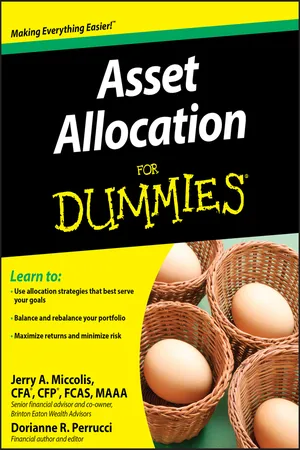Part I
Discovering the Not-So-Secret Recipe for Asset Allocation
In this part . . .
We start by looking at the big picture of asset allocation — from what seems like 30,000 feet. But as we talk about risk and return, and review the various asset classes and how to mix them together in the right proportions, you begin to focus in and see how getting that mix right is the single most important investment decision you can make. We also introduce portfolio rebalancing, which is a process overlooked by most investors but championed by the pros, to control risk and generate extra return.
Chapter 1
Understanding Asset Allocation
In This Chapter
Appreciating the importance of asset allocation
Discovering how to apply asset allocation to your portfolio
Getting started with building your portfolio
Going beyond the basics to get the most out of asset allocation
Psst! Want to know the trick to making a killing in investments? One that offers fat financial returns with little or no risk? Sadly (and as you’d probably guess), there’s no such thing.
Want to know how you can score great long-term investment results while minimizing unnecessary risk and costs? In that case, you’ve come to the right place! With the right asset allocation, you can enjoy substantial investment returns with the lowest possible amounts of risk and cost.
Asset allocation, in simplest terms, is deciding how to divvy up your investment dollars among various types of assets. More fully, it’s a comprehensive, coherent, top-down, strategic approach to investing that has well-established science and years of real-life superior investment results to back it up. In other words, it’s bona fide, and when it comes to investing, nothing consistently beats it.
In this chapter (and throughout this book), we show you how and why asset allocation works and, perhaps more important, how it can work for you. We take you step by step through the time-tested approach to investing that the most successful professionals use. We explain how you can reap the benefits of rebalancing, which is the closest thing to a free lunch you’ll ever find in investing. And we show you how to do all this and save on your taxes, too!
In true For Dummies fashion, Chapter 1 is a microcosm of the book that follows. Think of this chapter as a bird’s-eye view of asset allocation. We hit all the high points, and, as we go, we point you to the chapters you can visit to get a more detailed treatment of each topic.
Figuring Out Why Asset Allocation Is So Important
When it comes to your investments, what’s more important than asset allocation? In our opinion — and in the opinion of most every reputable investment expert — nothing.
In this section, we clue you in on why asset allocation is so important, using a couple different perspectives. First, we use the infamous story of Enron to show you the terrific power of diversification, which is one of several fundamental aspects of asset allocation. Then, to give you a feel for asset allocation’s other key aspects, we use the rest of the section to take a broader view, exploring what independent studies have to say about the role of asset allocation in driving investment success.
Encapsulating the Enron story
Here’s the short version of the Enron story: Beginning in the early 1930s as a modest oil pipeline company, Enron grew over the years, through mergers and acquisitions of other energy companies. By the late 1990s, it was very aggressive in energy trading and other complicated financial engineering ventures. (Don’t worry about the details — it was really, really complex stuff.) Enron had, in fact, become an industry leader and business-school case study in the creative use of these sophisticated financial arrangements. By early 2001, Enron had grown to be the seventh largest company in the United States based on revenue and had been named America’s Most Innovative Company for the sixth year in a row by Fortune magazine. It was also on Fortune’s 100 Best Companies to Work for in America list in 2000.
Then the bottom fell out. Before the end of 2001, Enron was bankrupt. The cause was accounting fraud. The lengths to which Enron’s executives went to conceal their illegal activities were epic in their ingenuity and complexity. That’s the white-collar-crime part of the story that was splashed all over news headlines for months. But that’s not the worst part.
The worst part — and the part most relevant to you, the average investor — was this: Even while the Enron executives were perpetrating their fraud, they were encouraging their own employees to stake their financial futures on the company. In addition to offering an employee stock ownership plan (ESOP), Enron urged its employees to i...


